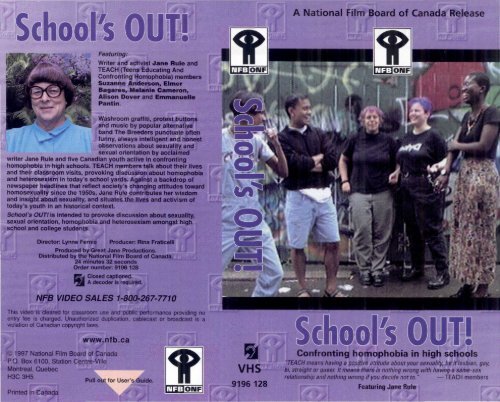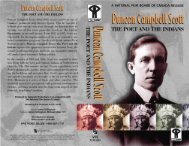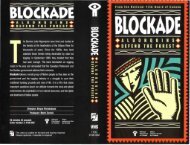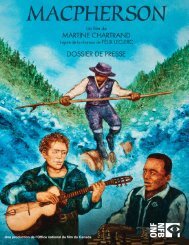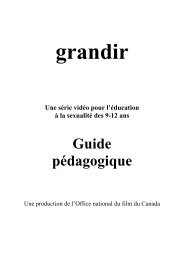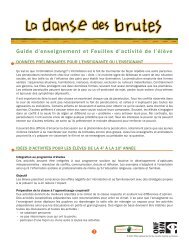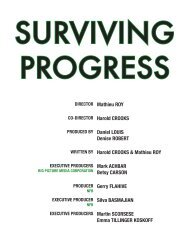A National Film Board of Canada Release - Office national du film ...
A National Film Board of Canada Release - Office national du film ...
A National Film Board of Canada Release - Office national du film ...
Create successful ePaper yourself
Turn your PDF publications into a flip-book with our unique Google optimized e-Paper software.
A <strong>National</strong> <strong>Film</strong> <strong>Board</strong> <strong>of</strong> <strong>Canada</strong> <strong>Release</strong><br />
,<br />
:<br />
Featuring:<br />
Writer and activist Jane Rule and<br />
TEACH (Teens E<strong>du</strong>cating And<br />
Confronting Homophobia) members<br />
Suzanne Anderson, Elmer<br />
Bagares, Melanie Cameron,<br />
Alison Dover and Emmanuelle<br />
Pantin.<br />
Washroom graffiti, protest buttons<br />
and music by popular alternative<br />
band The Breeders punctuate <strong>of</strong>ten<br />
funny, always intelligent and honest<br />
observations about sexuality and<br />
sexual orientation by acclaimed<br />
writer Jane Rule and five Canadian youth active in confronting<br />
homophobia in high schools. TEACH members talk about their lives<br />
and their classroom visits, provoking discussion about homophobia<br />
and heterosexism in today's school yards. Against a backdrop <strong>of</strong><br />
newspaper headlines that reflect society's changing attitudes toward<br />
homosexuality since the 1950s, Jane Rule contributes her wisdom<br />
and insight about sexuality, and situates the lives and activism <strong>of</strong><br />
today's youth in an historical context.<br />
School's OUT! is intended to provoke discussion about sexuality,<br />
sexual orientation, homophobia and heterosexism amongst high<br />
school and college students.<br />
Director: Lynne Fernie Pro<strong>du</strong>cer: Rina Fratieelli<br />
Pro<strong>du</strong>ced by Great Jane Pro<strong>du</strong>ctions.<br />
Distributed by the <strong>National</strong> <strong>Film</strong> <strong>Board</strong> <strong>of</strong> <strong>Canada</strong>.<br />
24 minutes 32 seconds<br />
Order number: 9196 128<br />
Closed captioned.<br />
A decoder is required.<br />
NFB VIDEO SALES 1-800-267-7710<br />
This video is cleared for classroom use and public performance providing no<br />
entry fee is charged. Unauthorized <strong>du</strong>plication, cabtecast or broadcast is a<br />
violation <strong>of</strong> Canadian copyright laws.<br />
www.nfb.ca<br />
© 1997 <strong>National</strong> <strong>Film</strong> <strong>Board</strong> <strong>of</strong> <strong>Canada</strong><br />
P.O. Box 6100, Station Centre-Ville<br />
Montreal, Quebec<br />
H3C 3H5<br />
Pull out for User's Gi<br />
inted in <strong>Canada</strong><br />
VHS<br />
9196128<br />
Confronting homophobia in high schools<br />
'TEACH means having a positive attitude about your sexuality, be it lesbian, gay,<br />
hi, straight or queer. It means there is nothing wrong with having a same-sex<br />
relationship and nothing wrong if you decide not to. " — TEACH members<br />
Featuring Jane Rule
USER'S GUIDE<br />
School's OUT!<br />
Confronting homophobia in high schools<br />
School's OUT! is meant to provoke discussion about sexual<br />
orientation, examine some <strong>of</strong> the stereotypes about lesbian and gay<br />
youth and look at the reasons why youth <strong>of</strong>ten use homophobic terms<br />
to put down their peers. It will help students to analyze the<br />
connections between sexism, racism, heterosexism and homophobia.<br />
Some viewers may respond with personal experiences <strong>of</strong> sexual,<br />
racial or homophobic harassment. Before screening the video, check<br />
with your school or workplace for policies and guidelines in order to<br />
provide appropriate advice and/or further resources.<br />
SETTING GROUND RULES FOR DISCUSSION<br />
Talking about sexual orientation can be difficult for youth who are in<br />
the process <strong>of</strong> learning about their sexuality. Setting some ground<br />
rules will help create a safe environment so students may express<br />
their feelings, examine their fears and learn from other students.<br />
Respect each other. Think about ways to disagree that will allow the<br />
other person to understand your point rather than feel attacked.<br />
Don't use demeaning language to describe others' ideas or actions.<br />
Group members should respect one another's need to take time out if<br />
they need to examine feelings <strong>of</strong> fear or anger. Ask people to suggest<br />
other ground rules. Agreements about confidentiality, no interrupting<br />
and - while humour can facilitate discussion about sexuality -<br />
no laughing at others' beliefs can encourage participants to speak.<br />
Depending on the group and its context, you may also suggest that<br />
participants not ask other members about their personal sexual<br />
orientation <strong>du</strong>ring the discussion.<br />
Don't make assumptions. There may be gay, lesbian or bisexual<br />
people in your group, youth who are not sure about their sexual<br />
orientation and people with gay brothers, sisters or parents. Think<br />
about how they might feel about your comments before you speak.<br />
for more<br />
Director<br />
Lynne Fernie<br />
Pro<strong>du</strong>cer<br />
Rina Fraticelli<br />
Camera<br />
Zoe Dirse<br />
Kim Derko<br />
Sound Recordist<br />
Justine Pimlott<br />
Editor<br />
Celest Natale<br />
Original Music<br />
Kathryn Moses<br />
The Breeders<br />
Order number:<br />
9196 128<br />
24 minutes<br />
32 seconds<br />
RELATED NFB VIDEOS<br />
OUT: Stories <strong>of</strong> Lesbian and Gay Youth Classroom version.<br />
An extensive User's Guide is included.<br />
Order number: 9193 125 (39:00)<br />
Taking Charge (Part <strong>of</strong> the Teens Against Violence collection)<br />
Teenagers address issues <strong>of</strong> violence against women, racism<br />
and homophobia. Includes a pull-out User's Guide.<br />
Order number: 9196 020 (26:00)<br />
Fiction and Other Truths: A <strong>Film</strong> About Jane Rule The life<br />
and work <strong>of</strong> the acclaimed author and social activist.<br />
Order number: 9194 132 (57:00)<br />
Jane Rule—writing<br />
Writer and activist Jane Rule talks about her work, with analysis<br />
by feminist literary pr<strong>of</strong>essor Marilyn Schuster.<br />
Order number: 9196 129 (26:00)<br />
WHY YOU SHOULD USE THIS VIDEO<br />
• Lesbian, gay, bisexual and straight youth have the right to a safe<br />
environment in their schools.<br />
• 28% <strong>of</strong> lesbian and gay youth drop out <strong>of</strong> high school.<br />
' Homophobic words are used as weapons to attack youth.<br />
• Suicide is the leading cause <strong>of</strong> death for lesbian and gay youth.<br />
> A discussion about sexual orientation will help students who are<br />
struggling with these issues.<br />
For further resources about sexual orientation and rights issues,<br />
check your telephone book to see if your city has a lesbian, gay<br />
and bisexual organization, or contact local health and e<strong>du</strong>cation<br />
boards.
BEFORE THE SCREENING<br />
Intro<strong>du</strong>ce this video as one in which well-known Canadian novelist<br />
Jane Rule, and youth who visit high schools, talk about sexual<br />
orientation and the impact <strong>of</strong> homophobia on their lives. A brief<br />
explanation <strong>of</strong> sexual orientation and some <strong>of</strong> the terms given in the<br />
glossary, and positioning the struggle for lesbian and gay rights in<br />
relationship to other struggles for equal rights, will help participants to<br />
consider their contribution to later discussion. Ask viewers to make a<br />
note <strong>of</strong> statements or issues in the video that they'd like to talk about<br />
with the group.<br />
AFTER THE SCREENING<br />
Questions:<br />
1. When someone calls another person a "faggot" or "dyke,"<br />
what are they trying to do? Have you ever seen or overheard<br />
someone being called homophobic names? How did that make<br />
you/them feel? How do you think homophobia is similar to sexism,<br />
racism and other prejudices?<br />
2. Elmer says that he thinks that boys sometimes act homophobic<br />
because they're afraid <strong>of</strong> being seen as gay. Why? Are boys afraid <strong>of</strong><br />
being seen as gay because it is considered feminine? How do these<br />
feelings relate to sexism?<br />
3. Can you think <strong>of</strong> any gay or lesbian characters on television or in<br />
the movies? What kind <strong>of</strong> characters are they and how are they<br />
portrayed? What are the responses <strong>of</strong> heterosexual characters<br />
to them?<br />
Projects:<br />
1. Jane says that "addressing fears is addressing barriers to people's<br />
creativity, to their love, to their courage to change society." Have<br />
students think <strong>of</strong> ways to make their schools and communities safe<br />
and comfortable for lesbian, gay and bisexual people.<br />
A BRIEF GLOSSARY OF TERMS<br />
SEXUAL ORIENTATION: The physical and emotional attraction <strong>of</strong><br />
someone to persons <strong>of</strong> the opposite sex, same sex, or both.<br />
Three forms <strong>of</strong> sexual orientation are labelled: heterosexual,<br />
homosexual and bisexual.<br />
COMING OUT: The process through which lesbian, gay and<br />
bisexual people recognize their sexual preference and integrate<br />
this knowledge into their personal and social lives. It may also<br />
mean disclosure, as in, "I just came out to my parents."<br />
HOMOPHOBIA: Fear and hatred <strong>of</strong> homosexuality, <strong>of</strong>ten exhibited<br />
as prejudice, discrimination, name-calling, harassment and acts <strong>of</strong><br />
violence against those presumed to be homosexual.<br />
INTERNALIZED HOMOPHOBIA: The fear and hatred <strong>of</strong><br />
homosexuality that gays, lesbians and bisexuals may absorb into<br />
their self-images from the way they are treated in society.<br />
SEXISM: Discriminatory practices and beliefs directed against<br />
people because <strong>of</strong> their gender.<br />
HETEROSEXISM or COMPULSORY HETEROSEXUALITY: The<br />
assumption that heterosexuality is the only acceptable sexual<br />
orientation. The pressure to be heterosexual and the harassment<br />
<strong>of</strong> gays, lesbians and bisexuals is <strong>of</strong>ten used to try and enforce<br />
heterosexual behaviour.<br />
RACISM: Discriminatory practices and beliefs directed against<br />
people because <strong>of</strong> their skin colour, culture and/or religion.<br />
FAG/DYKE/QUEER: Terms used by participants in the video.<br />
Although used as insults by homophobic people, the terms are<br />
being reclaimed by many gays and lesbians who feel that by using<br />
them positively, the expressions will lose the ability to cause harm.<br />
2. Ask students to contribute to a code <strong>of</strong> behaviour or ethics which<br />
respects people's differences and is based on how people treat one<br />
another instead <strong>of</strong> on stereotypes <strong>of</strong> gender, race or sexual<br />
orientation.


